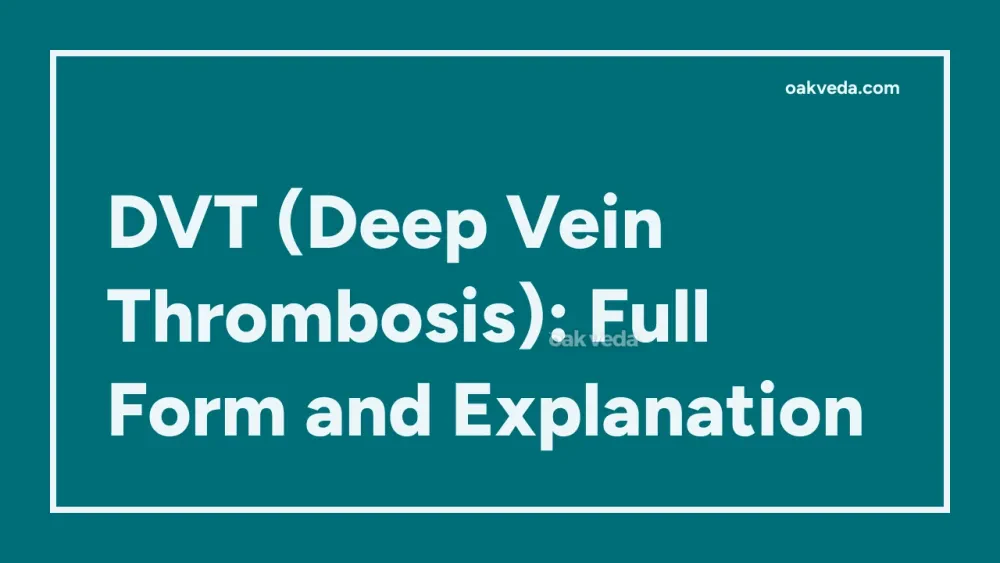
What is the Full Form of DVT?
DVT is the abbreviation for Deep Vein Thrombosis. This medical term refers to a serious condition where a blood clot forms in a deep vein, typically in the lower leg or thigh. However, DVT can occur in other areas of the body as well.
What is Deep Vein Thrombosis?
Deep Vein Thrombosis is a potentially life-threatening medical condition characterized by the formation of a blood clot (thrombus) in one or more of the deep veins in the body. These clots usually develop when blood flow is impaired or when the vein walls are damaged. DVT primarily affects individuals over the age of 50, but it can occur in people of all ages.
Causes and Risk Factors of DVT
Several factors can contribute to the development of Deep Vein Thrombosis:
- Prolonged immobility (e.g., long flights, bed rest)
- Recent surgery or injury
- Obesity
- Family history of DVT
- Use of birth control pills or hormone replacement therapy
- Pregnancy and postpartum period
- Smoking
- Certain medical conditions (e.g., cancer, heart failure)
Symptoms of Deep Vein Thrombosis
Recognizing the symptoms of DVT is crucial for early detection and treatment. Common signs include:
- Swelling in the affected leg, ankle, or foot
- Pain or cramping in the affected area
- Redness or discoloration of the skin
- Warmth in the affected region
- Tenderness along the vein
It's important to note that some people with DVT may not experience any symptoms at all.
Complications of DVT
Deep Vein Thrombosis can lead to serious complications if left untreated:
Pulmonary Embolism (PE)
The most severe complication of DVT occurs when a part of the blood clot breaks off and travels to the lungs, blocking a pulmonary artery. This condition, known as pulmonary embolism, can be life-threatening and requires immediate medical attention.
Post-thrombotic Syndrome
This long-term complication can develop after DVT, causing chronic venous insufficiency. It occurs when DVT damages the vein valves, leading to poor blood circulation in the affected limb. Symptoms may include persistent pain, swelling, and skin ulcers.
Limb Ischemia
In rare cases, severe DVT can cause limb ischemia, a condition where blood flow to the affected limb is significantly reduced. This can result in intense pain, skin ulcers, and in extreme cases, gangrene.
Diagnosis of DVT
If DVT is suspected, healthcare providers may use the following diagnostic tests:
- D-dimer Test: A blood test that detects fragments of blood clots in the bloodstream.
- Doppler Ultrasound: Uses sound waves to visualize blood flow in the veins and identify clots.
- Venography: An X-ray procedure that uses a special dye to highlight blood flow in the veins.
Prevention of Deep Vein Thrombosis
Taking preventive measures can significantly reduce the risk of developing DVT:
- Stay active and avoid prolonged periods of sitting or standing
- Maintain a healthy weight
- Exercise regularly
- Quit smoking
- Stay hydrated
- Wear compression stockings if recommended by your doctor
- Move your legs frequently during long trips
Treatment Options for DVT
Treatment for Deep Vein Thrombosis typically involves:
- Anticoagulants: Medications that prevent blood clots from growing or forming new ones.
- Thrombolytics: In severe cases, drugs that dissolve blood clots may be administered.
- Compression Stockings: These help prevent blood from pooling in the legs.
- Inferior Vena Cava (IVC) Filter: A device implanted to catch blood clots before they reach the lungs.
Future Developments in DVT Management
Research in DVT management is ongoing, with focus areas including:
- Improved diagnostic techniques for early detection
- Development of novel anticoagulants with fewer side effects
- Enhanced prevention strategies for high-risk individuals
- Personalized treatment approaches based on genetic factors
FAQs on DVT Full Form
-
What does DVT stand for in medical terms? DVT is the full form of Deep Vein Thrombosis, a condition where a blood clot forms in a deep vein.
-
Can DVT be life-threatening? Yes, DVT can be life-threatening, especially if it leads to complications like pulmonary embolism.
-
How is DVT diagnosed? DVT is typically diagnosed using a combination of physical examination, medical history, and diagnostic tests such as ultrasound and blood tests.
-
Can DVT be prevented? While not all cases of DVT can be prevented, maintaining an active lifestyle, staying hydrated, and avoiding prolonged immobility can significantly reduce the risk.
-
Is DVT treatable? Yes, DVT is treatable with anticoagulant medications, compression therapy, and in some cases, more invasive procedures.
Understanding the full form of DVT and its implications is crucial for recognizing the signs and seeking timely medical attention. By staying informed and taking preventive measures, individuals can reduce their risk of developing this serious condition.
You may be interested in:

